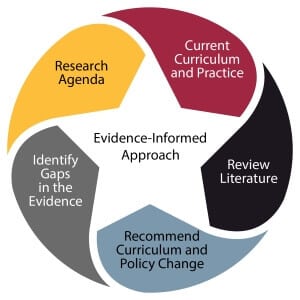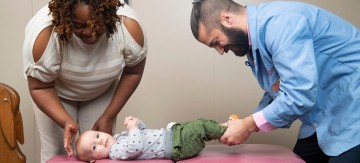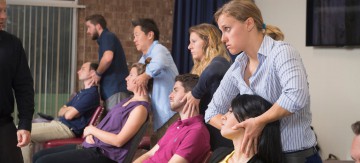[et_pb_section bb_built=”1″ admin_label=”section”][et_pb_row admin_label=”row”][et_pb_column type=”4_4″][et_pb_text admin_label=”Text” _builder_version=”3.0.49″ background_layout=”light” text_orientation=”center” border_style=”solid”]
Evidence-Informed Q&A with Dr. Christopher Kent
[/et_pb_text][et_pb_text admin_label=”Text” _builder_version=”3.0.49″ background_layout=”light” text_orientation=”left” border_style=”solid”]

Kent is responsible for overseeing and directing the initiation and collaboration of projects and studies with faculty, students, and staff. Which increase the quality and quantity of evidence applicable to the curriculum and practice of chiropractic, with a special focus on the unique approach to the science, art, and philosophy of traditional/principled chiropractic. He is collaborating with academic deans to ensure the inculcation of the evidence into the curriculum and clinical practice.
Sherman Magazine asked him a few questions about his role at the college and how a focus on evidence-informed practice and curriculum can impact the profession.
What exactly is evidence-informed practice?
It is difficult to attend a chiropractic meeting without encountering some discussion of evidence-based practice. The concept is simple and as old as the healing arts. Sackett defines evidence-based practice as “the conscientious, explicit, and judicious use of the current best evidence in making decisions about the care of individual patients. … [It] is not restricted to randomized trials and meta-analyses. It involves tracking down the best external evidence with which to answer our clinical questions.”1
Evidence-based practice is giving way to evidence-informed practice. An additional dimension has been added to the equation – patient preferences. As Umscheid noted, “patient preferences are critically important to clinical decision making and patient care.”2
What does this mean to the Sherman College family?
The mission of Sherman College of Chiropractic is to educate and prepare students to become doctors of chiropractic. This mission is based upon the college’s core values and is achieved through activities in the areas of education, research, and service. In particular, the research portion of the mission is as follows: ‘Faculty members engage in research and scholarly activities that contribute to the body of pedagogical and clinical knowledge which advance chiropractic education and the chiropractic profession.’3
What does this process look like on campus?
Evidence-informed practice is a continuous process. Once the concept is integrated into instruction and clinical practice, the objective of the instructor or practitioner is continual improvement through the integration of more and better evidence. Once the process becomes part of the culture of the institution, stakeholders hold one another accountable for staying current, engaging in scholarly activity, and exhibiting the traits of professionalism. Each stakeholder becomes a role model and mentor.
Evidence-informed curriculum and practice is an essential element of implementing these core values. The process involves the following steps:
- Evaluate the evidence base for each course. Is the material taught supported by textbooks, scientific literature, individual expertise, or a combination of these?
- Identify any gaps in the evidence for what is taught.
- Review the available literature to see which gaps can be filled.
- This may lead to recommendations for curriculum and policy change, and help develops a research agenda to fill the gaps that remain.

How will this focus on evidence benefit students as they graduate and enter practice?
Graduates will enter the field possessing the skills needed to track down the best available external evidence to apply in the care of their patients. This ability, coupled with their knowledge and skill in locating and correcting vertebral subluxations, will result in developing improved clinical strategies for individual patients.
How will our work in this area impact the profession?
Sherman College has the resources and resolves to lead the profession in developing an evidence-informed model for subluxation centered chiropractic. This involves determining the current evidence, identifying gaps in the evidence, conducting research to fill those gaps, and disseminating the results of that research to students and practitioner.
Sherman College will continue to be the leader in the research and science of vertebral subluxation and in the clinical practice of chiropractic.
Anything else to share?
Our goal is to create a culture committed to the expansion of our knowledge base, and clinical excellence. It involves the integration of academic, clinical, research, and outreach components.
References
- Sackett DL. Editorial. Evidence-based medicine. Spine, 1998; 23(10):1085.
- Umscheid CA. Should guidelines incorporate evidence on patient preferences? J Gen Intern Med, August 2009; 24(8):988–990.
- The Vision of Sherman College. Adjusting the World for a Better Future. https://www.sherman.edu/mission-statement/
[/et_pb_text][/et_pb_column][/et_pb_row][et_pb_row admin_label=”Row” _builder_version=”3.0.49″ background_position_1=”top_left” background_repeat_1=”no-repeat” background_position_2=”top_left” background_repeat_2=”no-repeat” background_position_3=”top_left” background_repeat_3=”no-repeat”][et_pb_column type=”1_3″][et_pb_post_nav admin_label=”Post Navigation” _builder_version=”3.0.49″ in_same_term=”off” hide_prev=”off” hide_next=”on” border_style=”solid” border_color=”#0c71c3″ title_font=”|on|||” title_font_size=”16px” /][/et_pb_column][et_pb_column type=”1_3″][/et_pb_column][et_pb_column type=”1_3″][et_pb_post_nav admin_label=”Post Navigation” _builder_version=”3.0.49″ in_same_term=”off” hide_prev=”on” hide_next=”off” border_style=”solid” border_color=”#0c71c3″ title_font=”|on|||” title_font_size=”16px” /][/et_pb_column][/et_pb_row][/et_pb_section]





